Spare sprinklers and an accurate list save building owners and maintenance pros time and hassle
Of the many inspection, testing, and maintenance (ITM) tasks for fire sprinkler systems, keeping spare heads and an accurate sprinkler list in a cabinet may seem minor. However, it prevents inspection violations and could help avoid impairments leading to lengthy building shutdowns.
Here’s why your property needs to maintain this list and what should be on it. We go over the National Fire Protection Association (NFPA) rules plus a slightly expanded version of the list with additional benefits:
- A brief review of the NFPA rules for spare sprinklers and lists
- The purpose of having spare fire sprinklers and a list
- What NFPA requires on the list
- Suggested additional information to make records more useful
- Buying spare sprinklers and cabinets
If you’re shopping for equipment, QRFS has you covered with spare sprinkler cabinets and the NFPA-required sprinklers and wrenches to stock them.
A brief review of the NFPA rules for spare sprinklers and lists
Both NFPA 13: Standard for the Installation of Sprinkler Systems and NFPA 25: Standard for the Inspection, Testing, and Maintenance of Water-Based Fire Protection Systems mandate keeping a stock of spare fire sprinklers on hand. Failing to do so is one “of the most cited deficiencies in sprinkler system inspections.”
All buildings with fire sprinklers need at least six extras (plus the wrenches needed to install them). But the specific number depends on how many sprinklers are in the system and how many different types. Here are the rules (some emphasis added below):
From the 2022 edition of NFPA 13
16.2.7.1* A supply of at least six spare sprinklers shall be maintained on the premises so that any sprinklers that have operated or been damaged in any way can be promptly replaced.
16.2.7.2* The sprinklers shall correspond to the types and temperature ratings of the sprinklers in the property.
16.2.7.5 The stock of spare sprinklers shall include all types and ratings installed and shall be as follows:
(1) For protected facilities having under 300 sprinklers — no fewer than six sprinklers
(2) For protected facilities having 300 to 1000 sprinklers — no fewer than 12 sprinklers
(3) For protected facilities having over 1000 sprinklers — no fewer than 24 sprinklers
Small systems with only one or two types of sprinklers have it pretty simple. However, keeping track of heads in a large, complex system and maintaining spares can get complicated.
In either case, NFPA 13 and 25 also require a list of all sprinkler types in the building to be in the cabinet housing the spares:
16.2.7.7 A list of the sprinklers installed in the property shall be posted in the sprinkler cabinet.
The purpose of having spare fire sprinklers and a list
The reason is simple: while not having extra fire sprinklers on the premises is a “noncritical deficiency” (the least urgent NFPA 25 problem), the spares can help prevent or mitigate system “impairments” (the worst issue).
If any sprinklers activate, show damage during an inspection, or otherwise need replacement, you can do it fast because you have extras. In practical terms, this prevents or minimizes violations—including potential building shutdown orders while waiting to swap out non-functional heads.
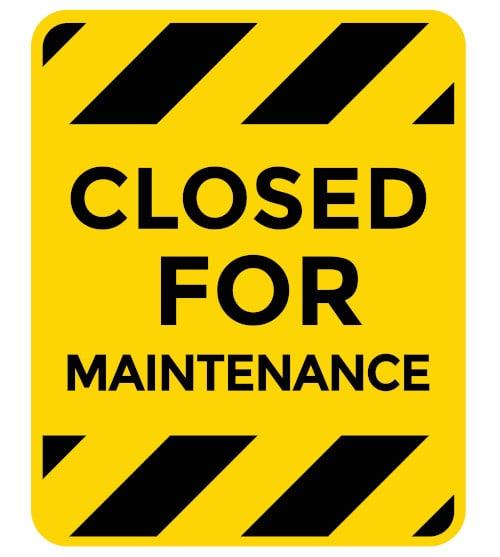
The requirement for a list in cabinets first appeared in NFPA 13’s 2007 edition. This accounting provides a reliable, easy-to-access snapshot of all the sprinklers in a system. At a glance, you’ll know what a given problem sprinkler is and precisely what to order to replace it.
However, this accounting may also benefit long-term testing and maintenance—especially if you slightly expand the information on the list from what NFPA 13 and 25 mandate.
What NFPA standards require on the list
NFPA 25 (2023 edition) has two pieces of guidance about what should be on the list (along with NFPA 13). The appendix (A.5.4.1.6.6.1) states the list should contain this “minimum information:”
(1) General description of the sprinkler, including upright, pendent, residential, ESFR, and so forth
(2) Quantity of sprinklers to be maintained in the spare sprinkler cabinet
However, the main section outlines slightly more detailed requirements:
5.4.1.6.6.1* The list shall include the following:
(1) Sprinkler identification number (SIN) if equipped; or the manufacturer, model, orifice, deflector type, thermal sensitivity, and pressure rating
(2) General description
(3) Quantity of each type to be contained in the cabinet
(4) Issue or revision date of the list
The appendix provides a sample list:
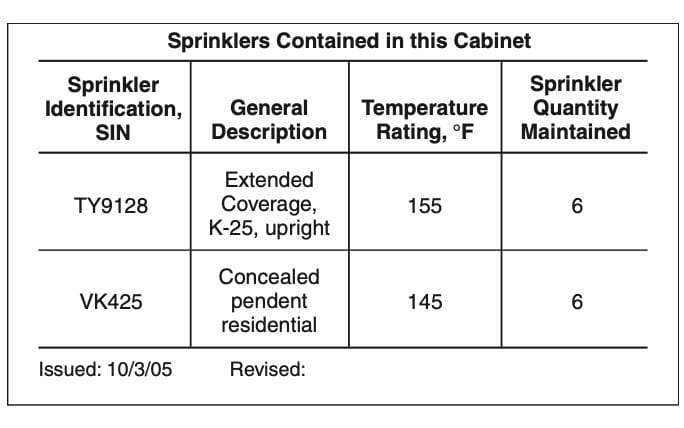
What else you need to know about sprinklers—and might want to add to the cabinet list!
1. Adding sprinkler finish
NFPA’s minimum list has crucial information, especially the SIN, which tells you the exact make and model, and the temperature rating. However, SIN + temperature don’t specify one piece of information needed to order the correct replacement sprinklers: their finish.
Often, picking the finish is just a matter of preference, and someone can eyeball it. However, some sprinklers have specific finishes that are listed for corrosion resistance. This feature may be necessary in certain environments and can actually change the lifespan (the testing or replacement interval) for sprinklers. Thus, you want to get the finish right!
For example, a Viking VK3021 quick-response pendent sprinkler is available in brass, chrome, white polyester, black polyester, and ENT finishes. But only white polyester, black polyester, and ENT are UL Listed for corrosion resistance, and only ENT is FM Approved for that purpose.
So, depending on what your system and authority having jurisdiction (AHJ) require, you may need to get the exact finish. Eyeballing things can often work, but some sprinklers (e.g., black PTFE vs. black polyester or ENT vs. stainless steel) can look similar.
So, why not just write down the appropriate finish on the sprinkler list? It avoids confusion in every case, but especially if a head needs corrosion resistance.
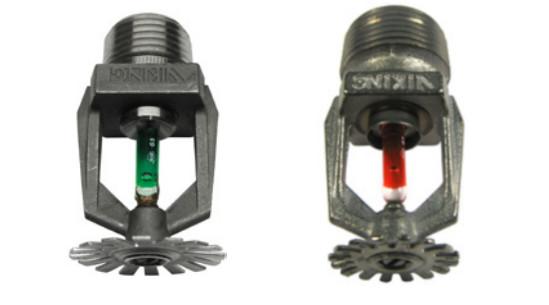
2. Adding the total number of sprinklers by type in the building (not just in the cabinet) and their in-service dates
NFPA standards specify having the “Quantity of each type to be contained in the cabinet” on the list, which is a useful number for maintaining an appropriate stock of extras. However, it may be beneficial to also list the total sprinklers of each type in the system and when they were first put there.
Why? Well, for one thing, fire sprinklers have a service life, at which point they need to be tested for functionality to see if they need replacement.
Sprinklers generally last a long time before this happens. Standard spray models first require testing and replacement at the 50-year mark. However, some types, like ESFR and dry heads, need initial testing at 20 years, and others, like sprinklers installed in harsh/corrosive environments, need it at 10 or five years.
To accomplish this test, a pro sends a sample of sprinkler types and different installation areas to a lab that assesses if they still work.
This effort starts with determining the total number of sprinklers and types. This information can be obtained through a detailed site survey or by checking the original plan documents. However, the planning and installation documents may not be readily available, especially if decades have passed.
So, you could simply add a column detailing how many of each type of sprinkler are in the system and the date when they first entered service. It should be fairly easy to complete this upon system installation. While this information may not provide an immediate benefit, whoever is responsible for the system (and their chosen fire protection pro) may be thankful for having that info handy years from now.
Here’s what a slightly expanded spare sprinkler cabinet list might look like (additions are highlighted):
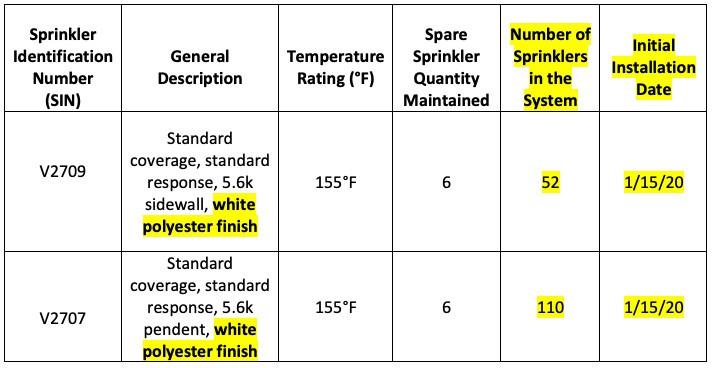
In addition, the extra info can give inspectors and authorities having jurisdiction (AHJs) a helpful snapshot of the system. For example, if they quickly see that one sprinkler is non-functional out of 30 (instead of out of, say, 6), it could help make the difference between quickly judging the problem as a critical deficiency vs. a total system impairment.
Fire protection ITM and design pros may also benefit from an initial snapshot if the system requires a recalculation when the building’s use changes, and these new challenges call for different sprinklers.
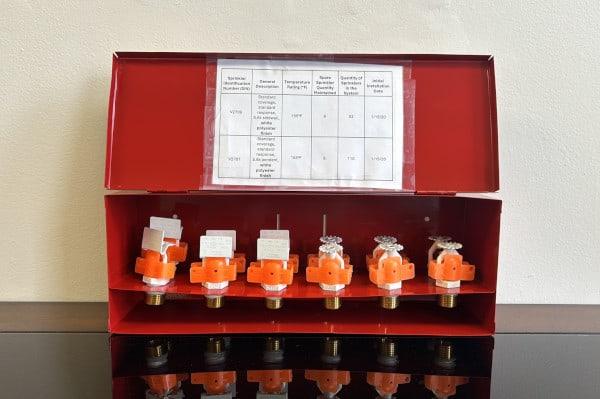
A simple but valuable item in sprinkler ITM
Building owners or their designated representatives should keep extra sprinklers on hand and maintain accurate details on them in the cabinet. It’s helpful and necessary for compliance with NFPA standards.
The minimum information NFPA mandates on the list is acceptable! Still, you might consider adding the information above—it’s especially easy when installing a new system or having the design documents handy. These extra details can simplify ordering replacement sprinklers plus have some maintenance benefits years down the road.
If you need spare heads, QRFS carries an extensive selection of Senju, Tyco, Reliable, Victaulic, and Viking fire sprinklers. We’ve also got the cabinets to store them and wrenches to install them!
If you have any questions or need help finding an item, contact us at 888-361-6662 or support@qrfs.com.
This blog was originally posted at blog.qrfs.com. If this article helped you, check us out at Facebook.com/QuickResponseFireSupply or on Twitter @QuickResponseFS.


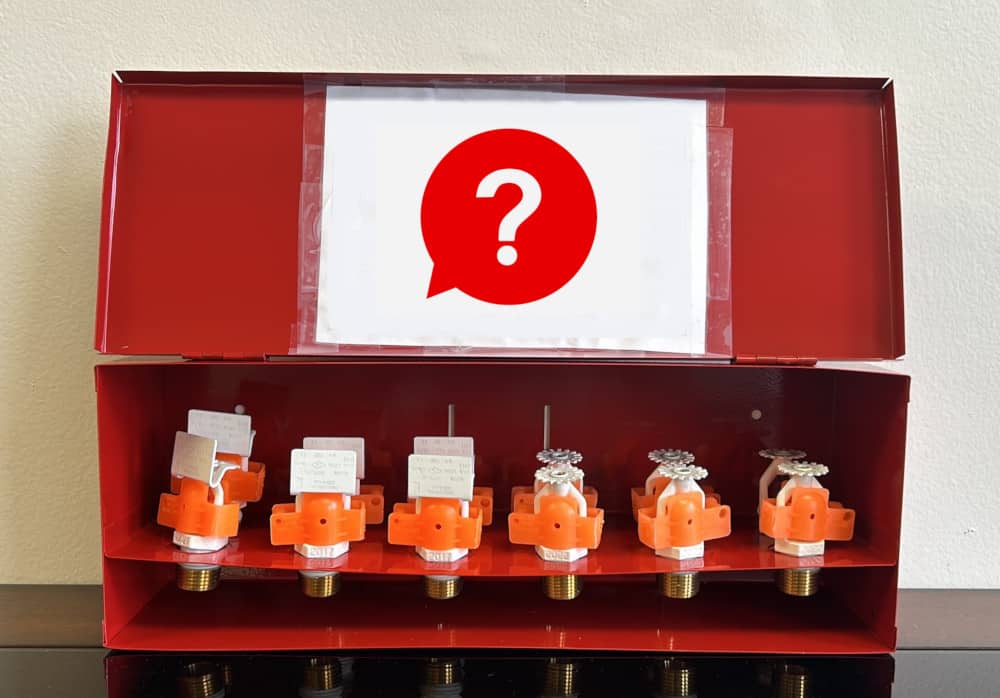
On the spare sprinkler list I prepare, I also list the wrench if multiple wrenches are needed.
David — That is also an excellent piece of info!